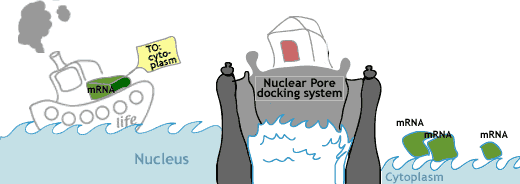Transport
Since the DNA is transcribed
into mRNA in the nucleus, and protein synthesis takes
place in the cytoplasm, the mRNA has to exit the
nucleus to the cytoplasm. The environment in the
nucleus differs in many ways from that of the
cytoplasm. To separate these two environments from
each other the nucleus is enclosed by a double
membrane, and the only connection to the surrounding
cytoplasm is through channels called the nuclear pore
complex (NPC).
When it is time for the mRNA to leave the nucleus,
the mRNA is believed to be "tagged" by proteins which
serve as export signals, directing the mRNA to the
nuclear pore complex that the mRNA is to leave. The
mRNA and it's bound export proteins then attaches to
export receptors and the whole complex (RNA, export
signal proteins and export receptors) is translocated
through the nuclear pore complex. The mRNA is
released into the cytoplasm and is immediately ready
for the next step: translation»
|
|
